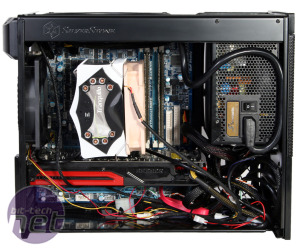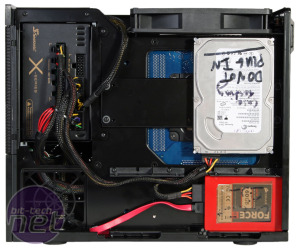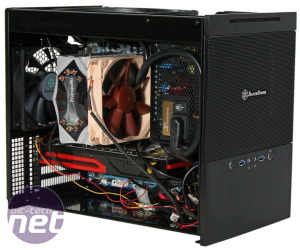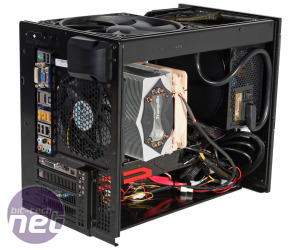
Performance Analysis
Unsurprisingly, the cooling results for the SG10 were within 1 or 2°C of the SG09, which is no bad thing. At its lowest speed, where the case is easily audible but far from loud, it manages a CPU delta T of 43°C, which is on par with the excellent SilverStone Temjin TJ08-E (that also utilises an Air Penetrator fan) on low speed. Its GPU result is a little higher than the Temjin, but is still 2°C cooler than the Corsair Obsidian 350D.

Click to enlarge - Longer graphics cards and extra internal drives will impede your ability to keep cables tidy
At medium speed, the CPU and GPU delta T results both shed 1°C from the low speed result, while the high speed setting produces results of 41°C and 44°C respectively, which places the SG10 second only to the Temjin TJ08-E on both counts. Naturally, noise increases as the fan speed does, but the jump to high speed is the most noticeable increment, and the case could easily be considered noisy in this state. As such, this setting is best suited for those looking for the very best temperatures or with the most demanding systems. For all other purposes, the confined space along with SilverStone's excellent trio of fans means that the low and medium speeds will easily provide sufficient airflow.


Click to enlarge - In this rotation, the internal PSU cable will push against the side 120mm intake fan
Conclusion
We've sung the praises of the SG10's space saving internal design in our SG09 review, and suffice it to say that it still manages to impress. The fact that it's possible to build a beast of a system in such a small space with no compromises on hardware size is reason enough to take note, but to also have it effectively cooled at reasonable noise levels says a great deal about SilverStone's achievements. Build quality is also excellent, and other than the usual caveats that come with smaller form factors, the case is easy to use once you've gotten used to its layout.At £100, the SG10 is a costly chassis, especially when both the SG09 and TJ08-E can be had for £15-£20 less. However, it's easy to view the SG10 as a combination of these two cases, with the TJ08-E's aluminium front panel and the SG09's wonderfully small dimensions and design merged into an attractive micro-ATX package that seemingly has it all. Coupled with the numerous other positives it has going for it, this means it's actually not as outrageously overpriced as it may first seem. Of course, other great cases like the Fractal Design Arc Mini can be had for a much more affordable price, but if you're looking to build a truly micro m-ATX system with as few compromises as possible, this is the case to get.

-
Cooling27 / 30
-
Features17 / 20
-
Design28 / 30
-
Value15 / 20


MSI MPG Velox 100R Chassis Review
October 14 2021 | 15:04








Want to comment? Please log in.